Lutetia increasingly came under attack from Germanic tribes.
To defend themselves, the Parisians consolidated the small islands on the Seine into a single large island—today's Île de la Cité.
Most of the Roman buildings on the Left Bank were dismantled, and their stones repurposed for fortifications.
A famous barbarian invasion occurred in 451 AD, when Attila the Hun and his army advanced towards Paris.
The legend goes that most Parisians attempted to flee the city but a local noblewoman, Genevieve, convinced them to stay.
The Huns redirected their attack to Orleans.
Genevieve became Sainte Geneviève, the patron saint of Paris.
The barbarian invasions culminated in the collapse of the Western Roman Empire.
Clovis, who became king of the Franks, made Paris his capital.
He converted to Christianity and built an abbey on the hill, the Abbaye Sainte Geneviève - part of which can still be seen today in the Lycée Henri IV and where he was buried with Sainte Geneviève.
The neighbourhood is rich with references from this era: rue Clovis, rue Clothilde (Clovis's wife), rue Clotaire (their son), the Bibliothèque Sainte Geneviève, and Montagne Sainte Geneviève.
The Frankish Kingdom became the largest kingdom in Western Europe.
The name Clovis gave rise to the name Louis - the name of 18 French kings.
Additionally, the term Frank gave rise to the name France!
















.jpeg)